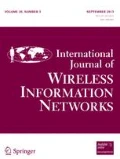Abstract
Cross-layer designs (CLDs) have the potential to better utilize network resources than a traditional layered protocol architecture, providing better communication services to end-users. This is particularly relevant in MANETs, which are characterized by a scarcity of network resources, in particular bandwidth. While many papers have demonstrated the potential performance benefit that CLDs can provide, their evaluation is often done under idealized scenarios, such as instantaneous message transmission times, complete topology knowledge, and/or zero message loss rates. Nodes in real MANETs do typically experience message losses, message delays, and have at best a partial and most likely inaccurate knowledge of the dynamic network topology. Our work focuses on realistic evaluations of a specific CLD approach. We propose a robust and stable version of a network utility maximization algorithm that optimizes the medium access probabilities at the MAC layer jointly with the end-to-end sessions rates at the transport layer. We report on stability tests with different link failure scenarios in case of synchronous and asynchronous message updates, convergence speed, and link utilizations. The results show that the algorithm converges even with a very high rate of link transmission failures and can tolerate asynchronous parameters updates. The CLD fully utilizes the link capacities and provides a network capacity gain of up to 250 %. The proposed modified CLD approach is therefore both beneficial and practical for real MANETs.


















Similar content being viewed by others
References
S. S. Priya and K. Murugan, “Cross layer approach to enhance TCP performance over wireless networks,” Students’ Technology Symposium (TechSym), 2010 IEEE, pp. 171–176, April 2010.
E. C. Park, D. Y. Kim, H. Kim, and C. H. Choi, “A cross-layer approach for per-station fairness in TCP over WLANs,” IEEE Transaction Mobile Computing, vol. 7, no. 7, pp 397–413, 2008.
X. Wang and D. Perkins, “Cross-layer hop-by-hop congestion control in mobile ad hoc networks,” IEEE wireless Communication Conference WCNC, LA, Apr. 2008.
W. Huang and K. B. Letaief, “Cross-layer scheduling and power control combined with adaptive modulation for wireless ad hoc networks,” in Proceedings of Global Telecommunications conference, GLOBECOM’2005, St. Louis, MO, Dec. 2005.
E. Setton, T. Yoo, X. Zhu, A. Goldsmith, and B. Girod, “Cross-layer design of ad hoc networks for real-time video streaming,” IEEE Wireless Communication, pp. 59–65, Aug. 2005.
V. Kawadia and P. Kumar, “A Cautionary Perspective on cross layer design,” IEEE Wireless Communication Magazine, vol. 12, no. 1, pp. 3–11, Feb. 2005.
X. Wang and K. Kar, “Cross-layer rate optimization for proportional fairness in multihop wireless networks with random access,” IEEE Journal Selected Areas in Communications, vol. 24, no. 8, pp. 1548–1559, Aug. 2006.
J.-W. Lee, M. Chiang, and A. R. Calderbank, “Utility-optimal random-access control,” IEEE Transaction Wireless Communication, vol. 6, no. 7, pp. 2741–2751, Jul. 2007.
J. W. Lee, M. Chiang, and R. A. Calderbank, “Jointly optimal congestion and contention control in wireless ad hoc networks,” IEEE Communication letters, vol. 10, no. 3, Mar. 2006.
Y. Yu and G. B. Giannakis, “Cross-layer congestion and contention control for wireless ad hoc networks,” IEEE Transaction Wireless Communication., vol. 7, no. 1, pp. 37–42, Jan. 2008.
F. P. Kelly, A. K. Maulloo, and D. K. H. Tan, “Rate control in communication networks: shadow prices, proportional fairness and stability,” Journal Optical Research Society, vol. 49, pp. 237–252, Mar. 1998.
D. Feijer and F. Paganini “Krasovskii’s method in the stability of network control,” American Control Conference (ACC’09), St. Louis, Missouri, USA, pp. 3292–3297, 2009.
M. Mardani, S.-Jun Kim, and G. B. Giannakis “Cross-layer design of wireless multihop random access networks,” IEEE Transaction Signal Processing, vol. 60, no. 5, May 2012.
S. Supittayapornpong and P. Saengudomlert, “Joint flow control, routing and medium access control in random access multi-hop wireless networks,” IEEE International Conference of Communications. (ICC), Dresden, Germany, pp. 1–6, Jun. 2009.
L. Chen, S. Low, and J. Doyle, “Joint congestion control and media access control design for ad hoc wireless networks,” in Proc. IEEE INFOCOM, Miami, FL, Mar. 2005.
I. Jawhar, “A Flexible object-oriented design of an event-driven wireless network simulator”, Wireless Telecommunications Symposium (WTS), pp. 80–86, April 22–24, 2009.
G. Bianchi “Performance analysis of the IEEE 802.11 distributed coordination function,” IEEE Journal on Selected Areas in Communications, vol. 18, no. 3, Mar. 2000.
E. Natsheh, A. Jantan, S. Khatun, and S. Subramaniam, “Adaptive optimizing of hello messages in wireless ad-hoc networks,” The International Arab Journal of Information Technology, vol. 4, no. 3, July 2007.
M. Heissenbuttel and T. Braun, “Optimizing neighbor table accuracy of position-based routing algorithms,” IEEE INFOCOM 2005, Miami, Mar. 13–17, 2005.
Y. Jia, I. Nikolaidis, and P. Gburzynski, “Alternative paths vs. inaccurate link state information in realistic network topologies,” in Proceedings of SPECTS 2002, San Diego, California, July 2002.
R. A. Alsaqour, M. S. Abdelhaq, and O. A. Alsukour “Effect of network parameters on neighbor wireless link breaks in GPSR protocol and enhancement using mobility prediction model,” EURASIP Journal on Wireless Communications and Networking, May 2012.
Z. Li, S. Nandi, and A. K. Gupta, “Achieving MAC fairness in wireless ad-hoc networks using adaptive transmission control,” in Proceedings of the Ninth International Symposium on Computers and Communications, vol. 2, 2004.
Author information
Authors and Affiliations
Corresponding author
Rights and permissions
About this article
Cite this article
Alhosainy, A., Kunz, T. Robustness, Stability, and Gains of Utility Maximization Algorithms for Mobile Ad Hoc Networks. Int J Wireless Inf Networks 23, 257–272 (2016). https://doi.org/10.1007/s10776-016-0318-z
Received:
Accepted:
Published:
Issue Date:
DOI: https://doi.org/10.1007/s10776-016-0318-z




